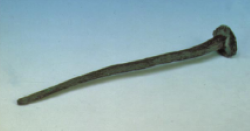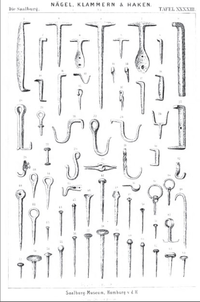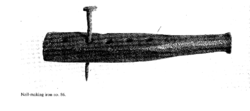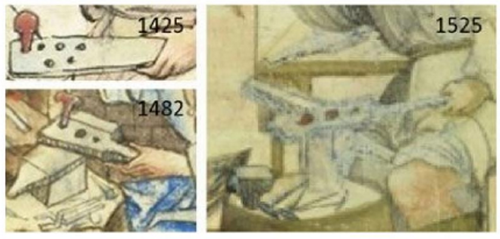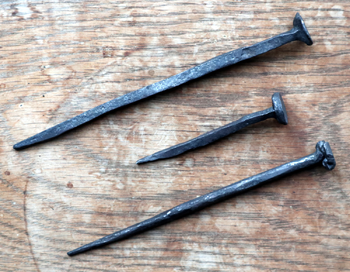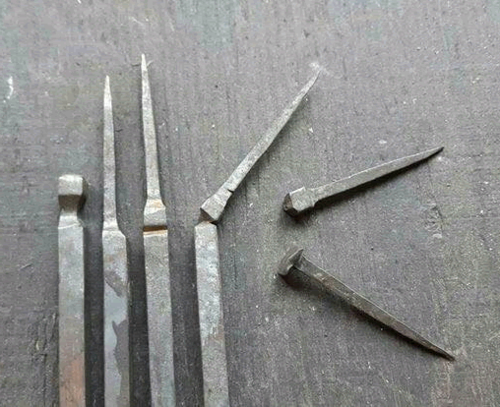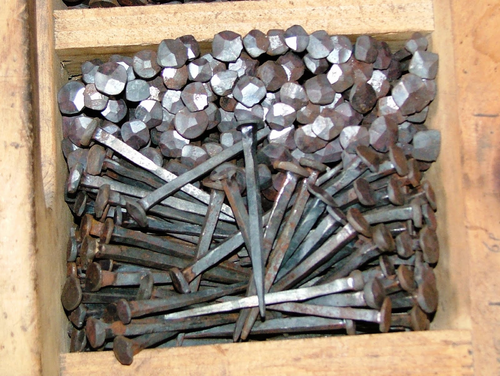A Short History of Nails: Difference between revisions
| Line 58: | Line 58: | ||
=== Tudor England === | === Tudor England === | ||
[[File:Medieval Forged Nails.png|center|350px|Wrought Nails]] | [[File:Medieval Forged Nails.png|center|350px|Wrought Nails]] | ||
A number of nails from the Mary Rose, built in 1509 and sunk in 1545 survived, even submerged in seawater because they were encased in tar. These nails look identical to the Roman examples.<ref name=EAL" /> | A number of nails from the Mary Rose, built in 1509 and sunk in 1545 survived, even submerged in seawater because they were encased in tar. These nails look identical to the Roman examples.<ref name="EAL" /> | ||
== Innovation Begins == | == Innovation Begins == | ||
Revision as of 18:04, 19 December 2020
Introduction
I've noticed a trend in all the woodworking circles I travel in (the SCA, SAPFM, various online furniture geek groups): a strong bias against the use of metal fasteners of any sort (nails, screws, rivets, etc.). I think some feel like it's a cheat. Like you couldn't think of some cleverly housed dovetail or another complex joint to use there rather than a vulgar nail? Or that's just it, it's suggestive of a lower class of furniture. Especially in SAPFM, there's a strong bias to only the highest style pieces. Stunning work often exceeding the originals in quality. But nary a nail to be found.
This is, of course, wrong-headed. There are many areas in furniture making that require a fastener, someplace you can't count on glue (especially hide glue) to survive over the long haul. Even those amazing 18th Century pieces have a few nails here and there to hold those bold pieces of trim, they are just hiding it well.
And there are many vernacular forms that are worthy of study and recreation where nails were what was used in the construction. Finally, there was a time before everything cool had dovetails. I just completed a project, a 15th Century Ambry, that was assembled with nails (as the original was).
Furniture from that period isn't studied or reproduced much because it's not very flashy or complex. This ambry and pieces like it were made by carpenters, not joiners and the trade of the cabinetmaker had yet to emerge. Carpenters built houses primarily and also simple furniture of a type that's called "boarded". This uses wide boards that are nailed or pegged together. This is a limited repertoire that gives you mostly variations on a box. Useful things, sturdy things, but heavy both physically and aesthetically. It's the strength of those fancy joints used by the joiner and the cabinetmaker that gave furniture the strength to shed their bulk.
Speaking of England specifically, there are basically two woodworking trades at the end of the 15th Century: carpenters (nascent joiners) and turners. As we get into the 16th Century and the level of wealth raises to the point where the demand for nicer furniture grows, we see first the joiner split off and then the cabinetmaker trade emerge. By charter (again, in England)* carpenters could only nail things together. Mortise and tenon joints were reserved for the joiner. And only cabinetmakers could use the more complex joints. Ans all of these guys were trying to keep the turners down.
There's a lot of fascinating history there, so at odds with the modern period furniture making crowd I am part of where we're a one-man shop that has to process stock, build the thing with whatever joinery is required, do turning and carving if required, then finishing, upholstering, etc. Few period craftsmen (of any period) were called upon to have such a wide range of skills.
But let's take it back to boarded furniture and nails. By the late fifteenth century, boarded or nailed furniture is associated with second rate or lower class furniture. Even so, it remained popular (there are a lot more peasants than nobles) such that many of these forms persisted until the industrial age put fashionable looking furniture into the reach of the working class.
What drew me to the ambry project was the 6 pierced gothic designed on the front of the cabinet. Ambries were used to store food and dry goods, so some sort of ventilation was required. They used these designs, backed by some sort of cloth to permit airflow and keep the food safe. Aside from the carving, an ambry is a bookshelf with a door, not a super complex or a challenging bit of woodworking.
Oh, and it was nailed together. I haven't used nails much in my previous projects. Not because I eschew vernacular or early period furniture, but because I suck at driving nails. I avoid them like the plague in my home renovation projects. Any line you can draw, I can saw, with a variety of saws. But I can bend the crap out of a nail like no one else. So I approached this project with some excitement to see if I could pull off the carving and fear that I would ruin it with a hammer trying to drive all these nails.
Since most people looking at the project would be unfamiliar with nails and their finer points (as it were), I felt that I needed to dive into nails a bit in the documentation. To give a little context, if nothing else. I came away with a lot more interesting information than I needed for the documentation. Not wanting such cool information to go to waste, I bring it all out into the light here in this article for the edification of all.
My goal is to illuminate the long history of nails, their importance to society, and their changes (or lack thereof) through history. As grand as that sounds, nothing much interesting happened to nails during the period focused on by the SCA as we'll soon see. Many of the references I found on nails prior to the Renaissance all point back to Henry C Mercer's Ancient Carpenter's Tools. As excellent a book as it is, with many photographs and good references, it's very nearly 100 years old now. A complete bibliography appears at the end on the off chance this length article doesn't satisfy your need to know about pointy metal things.
The History of Nails
Prehistory
Nails, especially iron nails, don't hold up well over the long haul so very old nails are very rare. More often we find nail making tools from which we can infer the size and composition of nails they made. The earliest nails found so far are bronze and date from about 3400 BCE. There are many references to nails in the Old Testament of the Bible implying they were widely known in the centuries before the Common Era.
Mediterranean
A wreck discovered off the Israeli coast, dated to approximately 400 BCE was found to be partly constructed with clenched copper nails. These were 7" to 12" long and based on the trace mineral content, the copper was from Cyprus.[1]
Romans
Beginning around the year 83 CE, the Romans began building the fortress Inchtuthil in what's now Perthshire in northern Scotland. This would turn out to be the most northerly military fort the Roman Empire ever constructed. After just 4 years, with parts of the fortress still under construction, the legion stationed there was moved further south and the fortress was partially dismantled and abandoned.
While excavating the site in the summer of 1960, archeologists discovered a horde of nearly 1 million iron nails ranging in size from 2 ½ inches to 15 inches long. This 10 ton batch of nails was no doubt made on-site during the construction of the fortress but deemed not worth transporting south. Therefore, they buried them to keep the Scots from recovering the high-quality iron and making weapons. You have to keep a close eye on those unruly Scots.[2]
Other examples of Roman use: Blacksmithing implements, including nail making tools and an iron woodworking plane, were found at Calleva near Reading, Hampshire, England dating from the 2nd-3rd century CE.
A 1st century CE nail-making anvil was among the tools found at a Roman camp near Kaiserlautern, Germany
A nail anvil was found, along with a perforated bar at the Saalburg Fortress, near Homburg vor der Hohe, Hesse, Germany. Occupied from 120 CE to about 250 CE. At the left is a number of items found at the fortress including, at the bottom, nails.[3]
Vikings
Yes, the Vikings used nails, a lot of nails. Those longships had lapstraked (longitudinal overlapping planks) hulls. A technique is also known as clinker-built and the planks were fastened together with copper or iron nails that were clenched or sometimes rivets. So it comes as no surprise to find several nail making tools in the Mästermyr Tools Chest from Gotland. And these tools are essentially identical to the Roman finds from a millennium earlier.[4]
At the right is an obore from the Mastermyr find. It's a tool used to form heads on nails.
Late Medieval Germany
The house books of the Mendelschen and Landauer Twelve Brothers contain over 1,300 illustrations describing all manner of crafts and manufacturing from the 15th to the 19th century. It contains 5 pictures of nail-smiths. Below is a compilation of three all showing the process of heading a nail. Compare this to the nail heading tool above from the Mastermyr find. The nail-smiths in the Mendel Housebook: Ott Nagler (c. 1425), Frycz Zorn (1482), Kuntz Peck (1525).
Tudor England
A number of nails from the Mary Rose, built in 1509 and sunk in 1545 survived, even submerged in seawater because they were encased in tar. These nails look identical to the Roman examples.[5]
Innovation Begins
From prehistory to 1580 nails have been made using the same two-step process:
- Create a sheet of iron, then cut the sheet into strips or rods
- Heat the rod stock, fashion a nail shank, clip off a piece, and create the head.
The image below from Colonial Williamsburg illustrates the steps:
In 1580, some folks in what is now Belgium invented a water-powered "slitting mill" and by 1590 a copy was operating in Dartford, England. This mill used a large cleaver to shear iron sheets into thin rods which were then sold to nail-smiths. This specialization allowed the smelting of iron and the creation of iron sheets to be separated from the task of actually making nails, greatly increasing production by increasing the number of smiths that could participate.
The resulting nails were identical to the previous ones in all respects and production continued to be rather slow.
Adam Smith, in The Wealth of Nations (1776), points out that by far the most efficient nail making came from shops devoted exclusively to the craft. He estimated that a common smith could produce 200- 300 nails per day--and very poor ones at that. A smith accustomed to making nails as a sideline fared better--his daily production would average between 800-1,000 nails. However, boys under twenty, trained exclusively in the trade, could by exertion produce up to 2,300 nails per day.
That sounds like a lot of nails, right? According to Colonial Williamsburg's Master Blacksmith Kenneth Schwarz recreating just one average-sized building consumed 30,000 nails of all types to fashion the framing, siding, roofing, and flooring. [5]
Things didn't change until the late eighteenth century.
Cut Nails
In 1775, Jeremiah Wilkinson, a Rhode Island inventor devised the first machine to cut individual nail blanks from iron sheets. The result still needed to be "headed" by another machine or by a nail-smith in the usual fashion.
Nails created with this process have a distinct shape with a blunt, usually rectangular cross-section rather than the pointed square cross-section of wrought nails and were called "cut nails" where hand-forged nails continued to be called "wrought nails".
By 1795 there were machines that could cut and head nails in one operation. These water-powered machines could churn out nails at a prodigious rate and cut nails quickly became the dominant form of nail. Wrought nails were still made and for a variety of reasons, some applications were too specialized for efficient mass production by the machinery of the day or places where clenching was needed, as this earlier type of cut nail wasn't pliable enough clench without breaking.
Machines continued to improve through the 1800s making more types of nails and at a faster rate.
Wire Nails
Wire nails, the type we are familiar with today, was developed in Europe in the middle of the nineteenth century. By the 1850s several wire nail factories were in operation in New York using machines either imported from Europe or copies of their designs. These machines produce smaller nails (2d and smaller).
Then American innovation took over and through the 1860s and 1870s the machines were improved and began making the full range of nails.
The development of the Bessemer process during the 1880s allowed for the production of inexpensive soft steel. The availability of cheap steel accelerated the adoption of the wire nail. Steel is drawn through plates to make wire of various sizes and a machine cuts it to length, creating the point in the process and heads it in one operation. These machines produced nails, faster and much more cheaply than the cut nail machines. And, the machines themselves were much simpler and less expensive.
An 1888 article states:
" Nails of a very different kind, manufactured from steel wire, have been in use for a number of years in America and for a longer period in Europe, and in both places, they have been very favorably received and are fast superseding the common cut-nails for many purposes."[6]
The popularity of using iron for nail making quickly waned. In 1886, 10 percent of the nails produced in the United States were made of soft steel wire. Within six years, more steel-wire nails were being produced than iron-cut nails. By 1913, 90 percent of the nails produced were wire nails.
References
- ↑ Shalev, S., Kahanov, Y. & Doherty, C. Nails from a 2,400 year old shipwreck: A study of copper in a marine archaeological environment. JOM 51, 14–17 (1999). https://doi.org/10.1007/s11837-999-0205-5
- ↑ Budrovich, N. From Ancient Scotland to Online Auctions: A Tale of Roman Nails. J. Paul Getty Museum (2020). https://brewminate.com/from-ancient-scotland-to-online-auctions-a-tale-of-roman-nails/ Retrieved 18 Dec 2020.
- ↑ Mercer, H. Ancient Carpenters' Tools (1929)
- ↑ Arwidsson, Greta and Berg, Gösta. The Mästermyr Find, A Viking Age Tools Chest from Gotland. Kungl. Vitterhets Historie Och Antikvitets Akademien, Almquist & Wiksell Intl., Stockholm, 1983.
- ↑ 5.0 5.1 LeFever, G. Forged and Cut Iron Nails. Early American Life Magazine, June 2008, pg 60-69.
- ↑ Unknown. "Builders' Hardware-III. Nails," The American Architect and Building News, Vol. XXIV, No. 660 (18 August 1888), 73.
